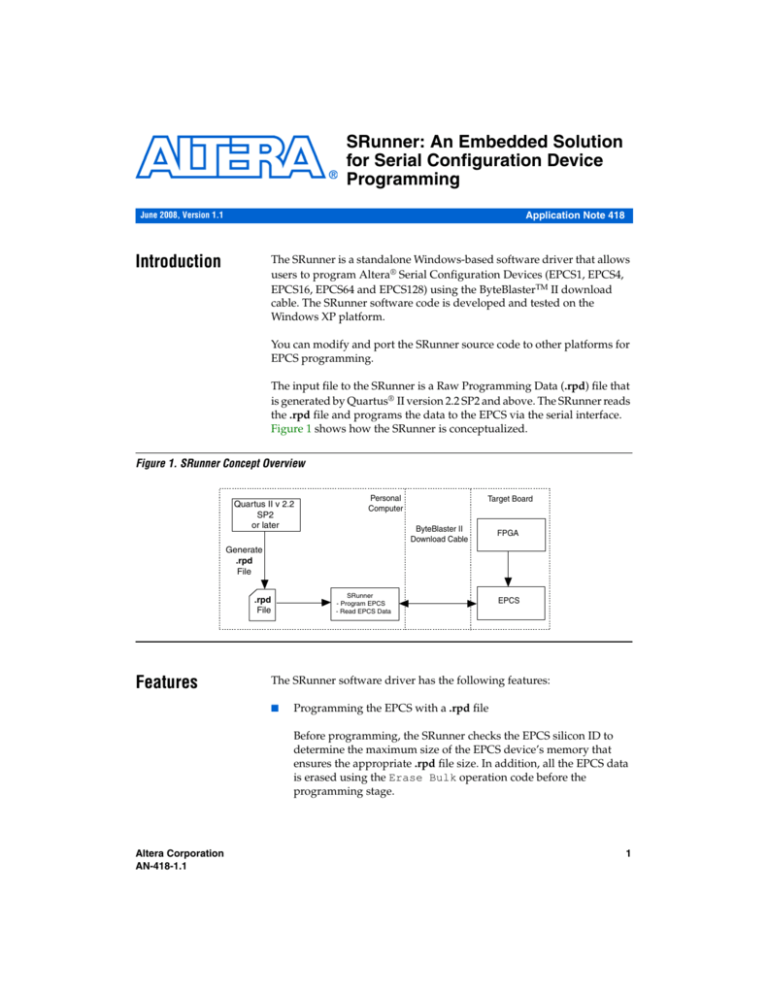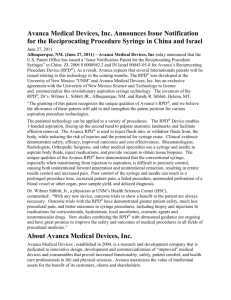
SRunner: An Embedded Solution
for Serial Configuration Device
Programming
Application Note 418
June 2008, Version 1.1
Introduction
The SRunner is a standalone Windows-based software driver that allows
users to program Altera® Serial Configuration Devices (EPCS1, EPCS4,
EPCS16, EPCS64 and EPCS128) using the ByteBlasterTM II download
cable. The SRunner software code is developed and tested on the
Windows XP platform.
You can modify and port the SRunner source code to other platforms for
EPCS programming.
The input file to the SRunner is a Raw Programming Data (.rpd) file that
is generated by Quartus® II version 2.2 SP2 and above. The SRunner reads
the .rpd file and programs the data to the EPCS via the serial interface.
Figure 1 shows how the SRunner is conceptualized.
Figure 1. SRunner Concept Overview
Quartus II v 2.2
SP2
or later
Personal
Computer
Target Board
ByteBlaster II
Download Cable
FPGA
Generate
.rpd
File
.rpd
File
Features
SRunner
- Program EPCS
- Read EPCS Data
EPCS
The SRunner software driver has the following features:
■
Programming the EPCS with a .rpd file
Before programming, the SRunner checks the EPCS silicon ID to
determine the maximum size of the EPCS device’s memory that
ensures the appropriate .rpd file size. In addition, all the EPCS data
is erased using the Erase Bulk operation code before the
programming stage.
Altera Corporation
AN-418-1.1
1
SRunner: An Embedded Solution for Serial Configuration Device Programming
During programming, the SRunner reads the configuration data
from the .rpd file and sends the data to the EPCS via the parallel port.
The configuration data is programmed into the EPCS using the
Write Bytes operation code.
■
Read back of EPCS data
With this feature, the SRunner creates a file to store data from the
EPCS. The SRunner reads the EPCS data by using the Read Bytes
operation code and stores the data byte from the EPCS in this file.
■
Verify EPCS data
With this feature, the SRunner verifies the content of the EPCS
against the content of data saved in the .rpd file. The SRunner reads
data by using the Read Bytes operation and compare the data
stored in the .rpd file. If mismatch occurs, SRunner will flag an error
to indicate the verification operation has failed.
f
Executing
SRunner
For more details about the EPCS devices, please refer to Serial
Configuration Devices (EPCS1, EPCS4, EPCS16, EPCS64 and EPCS128)
Data Sheet.
You must enter command instructions as shown in Table 1 when
executing the SRunner software driver.
Table 1. Instructions for SRunner
Instruction
Action
srunner -program -<EPCS density>
<filename1>.rpd
To open <filename1>.rpd and program the data from the
Raw Programming Data file.
srunner -read -<EPCS density>
<filename2>.rpd
To read out EPCS data and save in the <filename2>.rpd
file.
srunner -verify -<EPCS density>
<filename1>.rpd
To verify the EPCS data against the data saved in
<filename1>.rpd file.
Figure 2 shows the listing in the DOS command window when you
program an EPCS device with the srunner -program -<EPCS
density> <filename>.rpd instruction.
2
Altera Corporation
SRunner: An Embedded Solution for Serial Configuration Device Programming
Figure 2. Programming EPCS with the srunner -program -<EPCS density>
<filename>.rpd Command
Figure 3 shows the listing in the DOS command window when you read
from the EPCS device with the srunner -read -<EPCS density>
<filename>.rpd instruction.
Altera Corporation
3
SRunner: An Embedded Solution for Serial Configuration Device Programming
Figure 3. Reading EPCS Data with the srunner -read -<EPCS density>
<filename>.rpd Command
Figure 4 shows how the listing in the DOS command window when you
verify the data stored inside the EPCS device with the srunner verify -<EPCS density> <filename>.rpd instruction.
4
Altera Corporation
SRunner: An Embedded Solution for Serial Configuration Device Programming
Figure 4. Verifying EPCS Data with the srunner -verify -<EPCS density>
<filename>.rpd Command
Figure 5. SRunner Software Structure
.rpd
File
main.c
User interface to
execute read or
program command
Programming Cable
fs.c
File system module to
provide access to read,
write, open and close
.rpd file.
as.c
Active serial module
with
routine to erase, program,
read, and verify.
bb.c
Programming cable driver
to control the parallel port
for generating signal to the
cable.
When you execute a program or a read instruction, the SRunner software
driver respectively performs specific program and read steps. Figure 6
shows the program flow during the execution of the program and read
instruction using the SRunner.
Altera Corporation
5
SRunner: An Embedded Solution for Serial Configuration Device Programming
Figure 6. Program Flow During the Execution of Program, Read and Verify
Instructions
Read Function
Start
Verify Function
Start
Open .rpd File
Open .rpd File to Write
Open .rpd File to Write
Disable FPGA Access to EPCS
Disable FPGA Access to EPCS
Disable FPGA Access to EPCS
Read Silicon ID/
Read Device Identification ID (1)
Read Silicon ID/
Read Device Identification ID (1)
Programming Function
Start
Read Silicon ID/
Read Device Identification ID (1)
Bulk Erase Data
Read Data from EPCS
Read Data from EPCS
Program EPCS
Save Data in .rpd File
Read Data in .rpd File
Compare Data from EPCS
against Data from .rpd File
Enable FPGA Access to EPCS
Close .rpd File
End
Programming
Last
Byte ?
No
Yes
Enable FPGA Access to EPCS
Close .rpd File
Data
Matched ?
No
Yes
Last
Byte?
No
Yes
Enable FPGA Access to EPCS
Read
Function End
Close .rpd File
Verify
Function End
Note to Figure 6:
(1)
6
Only EPCS1, EPCS4, EPCS16 and EPCS64 devices support Read Silicon ID
operation. The EPCS128 supports Read Device Identification ID operation.
Altera Corporation
SRunner: An Embedded Solution for Serial Configuration Device Programming
Table 2 lists and describes the source files in SRunner.
Table 2. SRunner Source Files
File
Description
main.c
User interface module that reads user instructions.
as.c
Contains an active serial algorithm to erase, program, read and verify data on the
EPCS. The header file contains the Active Serial instruction set.
as.h
bb.c
ByteBlaster II and ByteBlaster MV driver directs the signal to the programming
cable (ByteBlaster MV is not used to program EPCS).
bb.h
fs.c
fs.h
File system module to open, close, create and read file
(for example, a .rpd file).
user.h
User-defined error code.
The active serial module (as.c) source file consists of various function calls
that perform the active serial algorithm to erase, program, read and verify
data on the EPCS. Table 3 lists and describes the function calls in the
active serial module.
Table 3. Functional Description for Active Serial Module (as.c) (Part 1 of 2)
Function
Description
as_program()
Executes during the srunner -program <filename1>.rpd command.
as_read()
Executes during srunner -read <filename1>.rpd command.
as_open()
Opens the programming file and initialize the parallel port.
as_close()
Closes the programming file and close the parallel port.
as_program_start
()
Disables the FPGA access to EPCS by pulling nCE high and nConfig
low. Initializes nCS pin to high.
as_program_done
()
Enables the FPGA access to EPCS by pulling nCE low and nConfig
high. Pulls nCS pin to high.
as_silicon_id()
Checks EPCS Silicon ID to ensure correct device is programmed.
as_bulk_erase()
Erases all the EPCS data.
as_prog()
Checks the Raw Programming Data size to determine the amount of
programming data to send to the programming cable. Read data from
.rpd File and send to the parallel port during EPCS programming.
as_verify()
Reads the EPCS data out and compare with the .rpd file to verify the
programming process is successful.
as_readback()
Reads back all the EPCS data and store in a .rpd file.
Altera Corporation
7
SRunner: An Embedded Solution for Serial Configuration Device Programming
Table 3. Functional Description for Active Serial Module (as.c) (Part 2 of 2)
Function
Description
as_program_byte_lsb()
Stores the data byte to the parallel port buffer LSB first and generates
a CLK signal (data is sampled by EPCS at rising edge) for
programming the data into EPCS.
as_read_byte_lsb()
Reads the EPCS data from the DATAOUT pin and stores it in a byte
buffer LSB first and generates a CLK signal (data is read at the rising
edge) for reading the EPCS in the Raw Programming Data file format.
as-program_byte_msb()
Stores the data byte to the parallel port buffer MSB first and generates
a CLK signal (data is sampled by EPCS at the rising edge) for sending
instruction sets and addresses to the EPCS.
as_read_byte_msb()
Reads the EPCS data from the DATAOUT pin, stores it in a byte buffer
MSB first and generates a CLK signal (data is read at rising edge) for
reading the status register from the EPCS.
as_lsb_to_msb ()
Convert one byte of data by changing the LSB to MSB.
Operation Code
and Data Out
Sequence
Diagram
Each configuration data byte in the .rpd file has been organized to ensure
the least significant bit (LSB) of each data byte is sent out first to the fieldprogrammable gate array (FPGA) devices during programming. In order
to meet this requirement, the LSB of data bytes in the .rpd file has to be
written first to the EPCS as shown in Figure 7. This format is different
from the operation codes and address bytes format.
For operation code and address bytes, SRunner needs to send the most
significant bit (MSB) first. Refer to Figure 7.
Figure 7. Timing Diagram During Programming EPCS by Using RPD File as Input
nCS
0
1
2
3
4
5
6
7
8
9
10
28
29
31
30
32
33
34
35
36
37
39
38
DCLK
Operation Code
ASDI
23
MSB
22
21
3
2
1
0
LSB
0
LSB of every
byte in .rpd file
Send MSB out first for operation code and address bytes
8
1
2
3
4
5
6
7
MSB of every
byte in .rpd file
Send LSB out first for raw programming data byte
(from RPD file).
Altera Corporation
SRunner: An Embedded Solution for Serial Configuration Device Programming
Raw
Programming
Data (RPD) File
Altera Corporation
The SRunner requires a .rpd file to be used as the input programming file.
You need to generate a Programmer Object File (.pof), then convert the
.pof file into a .rpd file.
Follow these steps to generate a .pof:
1.
On the File menu, click Convert Programming Files.
2.
In the Convert Programming Files dialog box, point to the
Programming file type menu and click Programmer Object file.
3.
In the Mode menu, click Active Serial Configuration.
4.
In the Configuration Device menu, click on a serial configuration
device.
5.
In the File Name text box, enter the file name and location for the
.pof file .
6.
In the Input files to convert section, point to SOF Data and click
Add File to add the SRAM Object File (.sof).
7.
Click Generate to generate a .pof as shown in Figure 8.
9
SRunner: An Embedded Solution for Serial Configuration Device Programming
Figure 8. Converting an SOF File to a POF File in Convert Programming Files
After compiling the project and generating the .pof file, convert the .pof
file into a .rpd file by using the Convert Programming Files dialog box in
the File menu. This is shown in Figure 9.
Follow these steps to generate an .rpd file from a .pof file:
10
1.
On the File menu, click Convert Programming Files.
2.
In the Convert Programming Files window, point to the
Programming file type menu and click Raw Programming Data
File.
3.
In the File Name text box, enter the file name and location for the
.rpd file.
4.
In the Input Files to Convert section, point to POF Data and click
Add File to add the .pof.
Altera Corporation
SRunner: An Embedded Solution for Serial Configuration Device Programming
5.
Click Generate to generate an .rpd file as shown in Figure 9.
Figure 9. Converting a POF File to an RPD File
Table 4 shows the file size for the generated .rpd file.
Table 4. RPD File Size for Serial Configuration Devices
Device
Altera Corporation
RPD File Size (bits)
EPCS1
1,048,576
EPCS4
4,194,304
EPCS16
16,777,216
EPCS64
67,108,864
EPCS128
134,217,728
11
SRunner: An Embedded Solution for Serial Configuration Device Programming
1
Pin Assignment
Remove the unused part (blank configuration data) of the .rpd
file by deleting part of the 0xFF, but leaving at least 36 bytes of
0xFF at the end of the .rpd file because they are part of the
required configuration data. This helps to reduce the required
programmming time. Use a hex editor tool to do the .rpd file
editing to prevent file corruption.
Because the writing and reading of the data to and from the I/O ports on
other platforms maps to the parallel port architecture, this document
describes the pin assignments of the active serial configuration signals
to the parallel port.
These pin assignments reduce the required source code modifications.
Figure 5 shows the assignment of the active serial configuration signals to
the parallel port.
The parallel port has a total of 12 digital outputs and five digital inputs
accessed via three consecutive 8-bit ports as shown in Table 5.
Table 5. Assignment of the Active Serial Configuration
Port
0
Description
Pins
Data Port (labeled with LPT_DATA in source code)
8 output pins
1
Status Port (labeled with LPT_STATUS in source code)
5 input pins (bit 7 inverted)
2
Control Port (labeled with LPT_CONTROL in source code)
4 output pins (bit 0, 1, 3 inverted)
Table 6 shows the pin assignments of the active serial configuration
signals to the parallel port.
Table 6. Pin Assignments of Active Serial Configuration Signals to the Parallel Port
Bit
7
6
5
4
3
2
1
0
Port
0
-
ASDI
-
-
nCE
nCS
nCONFIG
DLCK
Port CONF
1
_DONE
-
-
DATAOUT
-
-
-
-
Port
2
-
-
-
-
-
-
-
12
-
Altera Corporation
SRunner: An Embedded Solution for Serial Configuration Device Programming
Table 7 describes the function of the active serial configuration pins when
you use the SRunner software driver.
Table 7. Pin Description
Pin Name
Altera Corporation
Description
DCLK
SRunner generate a clock signal to EPCS via the DCLK pin.
ASDI
Data input signal for transferring data serially into the EPCS.
DATAOUT
Data output signal for transferring data serially out of the EPCS
to the parallel port during read/programming operation. During
read/programming operations, the EPCS is enabled by pulling
nCS low.
nCS
The active low chip select input signal toggles at the beginning
and end of a valid instruction. When this signal is high, the
EPCS is deselected and the DATA pin is tri-stated. When this
signal is low, it enables the EPCS and puts the device in an
active mode. After power up, the EPCS requires a falling edge
on the nCS signal before beginning any operation.
nCE
Active-low chip enable. When nCE is low, the FPGA is enabled.
SRunner uses this pin to disable the FPGA from accessing the
EPCS during programming.
nCONFIG
Configuration control input. Pulling this pin low during
user-mode causes the FPGA to lose its configuration data,
enter a reset state, and tri-state all I/O pins. Returning this pin
to logic high initiates a reconfiguration. SRunner will hold the
FPGA in reset mode by pulling this pin low during programming.
CONF_DONE
This is a dedicated configuration status pin, this pin goes high
after the configuration mode is completed.
13
SRunner: An Embedded Solution for Serial Configuration Device Programming
Porting
The software for SRunner is modular and is portable to other platforms
and embedded systems. If needed, you can port the as.c file into the
new platform and replace the current interfacing module with a
platform-specific interfacing module. Different platforms have different
ways of interfacing with I/Os and handling data in the memory.
For example, if you need to port source code into an embedded system,
some changes are required for the platform-dependent module as shown
in Table 8.
Table 8. Porting Change Option
Module
Platform
Dependent
Changes
main.c
Change to interface with other systems to execute the necessary
instruction/operation.
Yes
bb.c
Change to interface to either programming cable or directly to the
EPCS Pin assignment (reassign pins to other I/O pins).
Yes
fs.c
Change to access to the programming file (that is stored in other
memory).
Yes
as.c
Some minor changes if required.
No
Figure 10 shows the changes required when you port the SRunner into
other platforms.
Figure 10. Changes Required for Porting SRunner into Other Platforms
14
.rpd
File
main.c
User interface to
execute read or
program command
Programming Cable
fs.c
File system module to
provide access to read,
write, open and close
.rpd file.
as.c
Active serial module
with
routine to erase, program,
read, and verify.
bb.c
Programming cable driver
to control the parallel port
for generating signal to the
cable.
Altera Corporation
SRunner: An Embedded Solution for Serial Configuration Device Programming
You can also port the SRunner into an embedded system as shown in
Figure 11.
Figure 11. Reference for Porting SRunner into an Embedded System
Quartus II v2.2
SP2 or
later
SRunner on MicroProcessor Platform
Microprocessor access
to EPCS for
programming EPCS.
(Changes in bb module)
Microprocessor access
to memory for reading
.rpd file.
(Changes in fs module)
FPGA
Memory
MicroProcessor
.rpd
File
SRunner
EPCS
Generate .rpd file
and save in memory.
Conclusion
The SRunner is a standalone software driver developed for EPCS
programming and can be customized to fit in other systems and
embedded systems. The customizable driver allows fast and easy EPCS
programming using other platform-like microprocessor and tester
programs.
Referenced
Documents
■
Altera Corporation
Serial Configuration Devices (EPCS1, EPCS4, EPCS16, EPCS64 and
EPCS128) Data Sheet.
15
SRunner: An Embedded Solution for Serial Configuration Device Programming
Document
Revision History
Table 9 shows the revision history for this chapter.
Table 9. Document Revision History
Date and Document
Version
June 2008
v 1.1
Changes Made
—
●
Added new bullet ‘Verify EPCS data’ in the “Features”
section.
Updated Table 1.
Updated Figures 2, Figure 3, Figure 4 and Figure 6.
Added note to Figure 6.
Added another row for EPC128 in Table 4 .
●
Initial Release.
—
●
●
●
●
October 2006
v 1.0
101 Innovation Drive
San Jose, CA 95134
(408) 544-7000
www.altera.com
Applications Hotline:
(800) 800-EPLD
Literature Services:
literature@altera.com
Altera Corporation
Summary of Changes
Copyright © 2006 Altera Corporation. All rights reserved. Altera, The Programmable Solutions Company,
the stylized Altera logo, specific device designations, and all other words and logos that are identified as
trademarks and/or service marks are, unless noted otherwise, the trademarks and service marks of Altera
Corporation in the U.S. and other countries. All other product or service names are the property of their respective holders. Altera products are protected under numerous U.S. and foreign patents and pending
applications, maskwork rights, and copyrights. Altera warrants performance of its semiconductor products
to current specifications in accordance with Altera's standard warranty, but reserves the right to make changes to any products and services at any time without notice. Altera assumes no responsibility or liability
arising out of the application or use of any information, product, or service described
herein except as expressly agreed to in writing by Altera Corporation. Altera customers
are advised to obtain the latest version of device specifications before relying on any published information and before placing orders for products or services.
16





